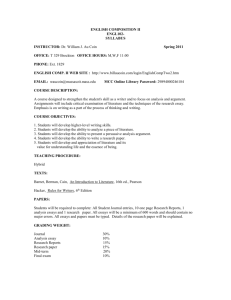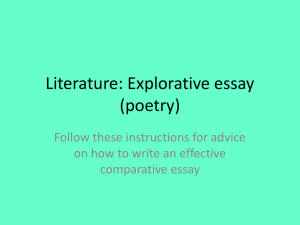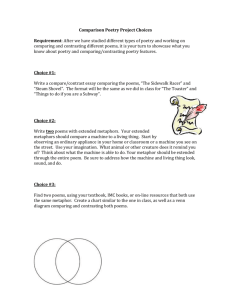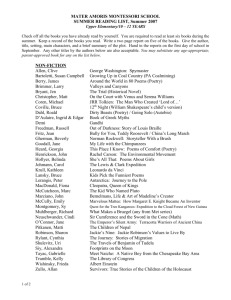AP Literature and Language Summer Institute:
advertisement
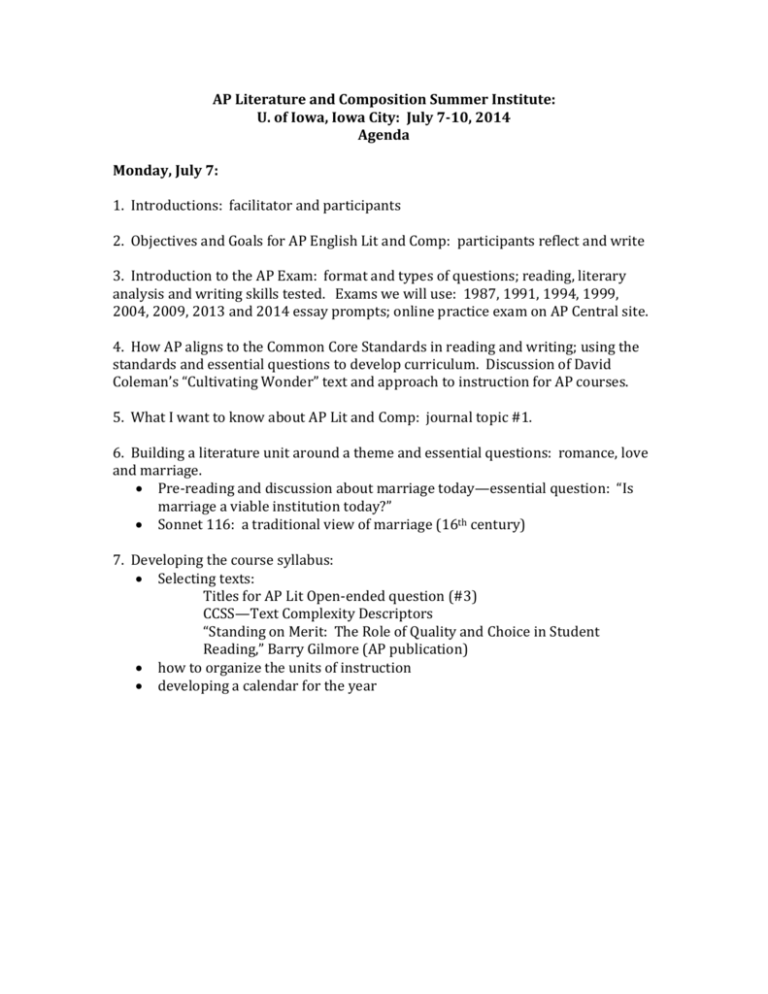
AP Literature and Composition Summer Institute: U. of Iowa, Iowa City: July 7-10, 2014 Agenda Monday, July 7: 1. Introductions: facilitator and participants 2. Objectives and Goals for AP English Lit and Comp: participants reflect and write 3. Introduction to the AP Exam: format and types of questions; reading, literary analysis and writing skills tested. Exams we will use: 1987, 1991, 1994, 1999, 2004, 2009, 2013 and 2014 essay prompts; online practice exam on AP Central site. 4. How AP aligns to the Common Core Standards in reading and writing; using the standards and essential questions to develop curriculum. Discussion of David Coleman’s “Cultivating Wonder” text and approach to instruction for AP courses. 5. What I want to know about AP Lit and Comp: journal topic #1. 6. Building a literature unit around a theme and essential questions: romance, love and marriage. • Pre-reading and discussion about marriage today—essential question: “Is marriage a viable institution today?” • Sonnet 116: a traditional view of marriage (16th century) 7. Developing the course syllabus: • Selecting texts: Titles for AP Lit Open-ended question (#3) CCSS—Text Complexity Descriptors “Standing on Merit: The Role of Quality and Choice in Student Reading,” Barry Gilmore (AP publication) • how to organize the units of instruction • developing a calendar for the year Tuesday, July 8: 1. Reading and writing about poetry: journal topic #2 • approaches to teaching poetry the five-minute write: Dickinson poems/other short poems “Ask me five questions” approach using the TP-CASTT approach to poetry analysis—“Beasts” and “The Groundhog” using essential questions to teach poetry • selecting poets and poetry to include; deciding when to teach certain poets and types of poems • exploring a poet of choice: paired student project on a poet of choice Using Dickinson as a model • comparing and contrasting poems on a similar topic or theme: Dickinson and Frost (2004 exam); “Helen and “To Helen” (1994 exam) • helping students identify tone, irony, and satire in poetry: “Did I Miss Anything” “Daddy” and “Mommy”—parody-writing assignment “The Indifferent” and other 17th century poems Titanic poems On lying to children: Wilbur and Collins poems 2. Writing essays about poetry: 2008 test as a model for assessing poetry essay responses. 3. Exploring the AP Website: test prep, support for instruction, PD opportunities Wed., July 9: 1. Selecting and reading short stories, novels, plays: journal topic #3. 2. Selecting fiction and plays to teach: authors, eras, sub-genres/types of texts to teach. Examining the 1971-2013 free response titles and prompts. 3. Helping students identify tone and irony in short stories and novels: “Judge Pyncheon” (1996 exam) “Desiree’s Baby” “Voice” student writing project (As I Lay Dying) 4. Questioning Texts: Hillocks’ levels of questions Genesis 3—participants practice writing questions at levels 4-7 Using biblical and classical texts together (e.g., Oedipus and Genesis 22) Interpreting classical texts, especially myths 5. Using the elements of fiction to determine meaning in a text: Setting, characterization, conflict, allusions in The Great Gatsby 6. Using Chopin’s The Awakening as a model: Essential question—“What approach would you take to teaching this novel?” • pre-reading survey on marriage: attitudes and opinions • critical approaches to the text—discussion of if, when, and how to use these • selecting an analytic focus: characterization (foils); conflict (internal conflicts); allusions and symbols (archetypal approach); irony • assessments of student understanding: what should these be for this novel? 7. Working on a performance event assessment individually (afternoon task) Thursday, July 10: 1. Responding to student writing: journal topic #4. Discussion of ways to facilitate and assess student writing in response to AP prompts and other responses to literature: what works? 2. Using Trifles (Susan Glaspell) as a model for teaching drama and for making thematic connections among genres: fiction, poetry, drama. 3. Discussing Fences (August Wilson) as a modern play that has significant, relevant themes that are often addressed in the open-ended question (essay 3). 3. Practicing with Renaissance Era plays: • Richard II (1991 exam) • Richard III (1983 exam) • Henry VIII (2009 exam) • Volpone (1999 exam) 3. Discussion of possible activities and assignments work in the last two weeks of May after the exam. 4. Discussion of administrative and equity issues: • Equity policy • Gaining administrative support for the AP program 5. Ideas for how to use technology to enhance instruction in AP Lit and Comp: brainstorm together. 7. Practice scoring essays for the Free Response Question #3 (2005 exam). Assessment: (for graduate credit) Participants attending the AP Literature Institute for graduate credit should submit the following: A 2-3 page double-spaced essay outlining their approach to teaching AP Literature, including a list of texts they will use, approaches they will take to instruction in the literature, and two examples of writing-based assignments they will give their students.

